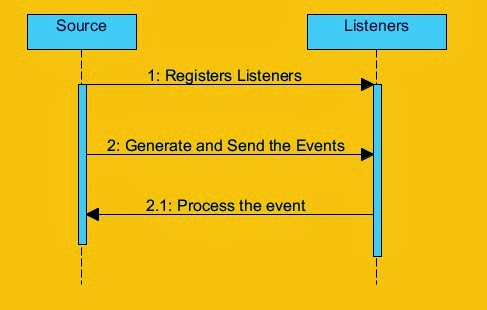Delegation
model concept is Very simple. Listeners Register with the source.
Source Generates the event, makes an event object and send it to the
listeners. Listeners Process the event object and returns.
Java
provides both the ways that a source can add listeners and can remove
the listeners also.
import javax.swing.*; import java.awt.event.*; public class MouseListenerEx implements MouseListener{ public void mouseClicked(MouseEvent e) { JOptionPane.showMessageDialog(null, "Mouse Clicked"); } public void mouseEntered(MouseEvent e) { JOptionPane.showMessageDialog(null, "Mouse Entered"); } public void mousePressed(MouseEvent e){ JOptionPane.showMessageDialog(null, "Mouse Pressed"); } public void mouseMoved(MouseEvent e){ JOptionPane.showMessageDialog(null, "Mouse Moved"); } public void mouseReleased(MouseEvent e){ JOptionPane.showMessageDialog(null, "Mouse Moved"); } public void mouseExited(MouseEvent e) { JOptionPane.showMessageDialog(null, "Mouse Exited"); } }
import java.awt.event.*; import javax.swing.*; class EventHandlingEx{ public static void main(String args[]){ JFrame myFrame = new JFrame("Event Handling Example"); MouseListenerEx listener1 = new MouseListenerEx(); /* Create a button */ JButton myButton = new JButton("Click Me"); myFrame.setVisible(true); myFrame.setSize(250, 250); /* Add Button to the frame */ myFrame.add(myButton); /* Registers the Listeners */ myButton.addMouseListener(listener1); } }
As
You Observe the program, Mouse events register with myButton.
Source
: myButton
Listener
: MouseListener
So
Whenever any event occurs, then source generates an event object and
send it to the registered listeners.





No comments:
Post a Comment